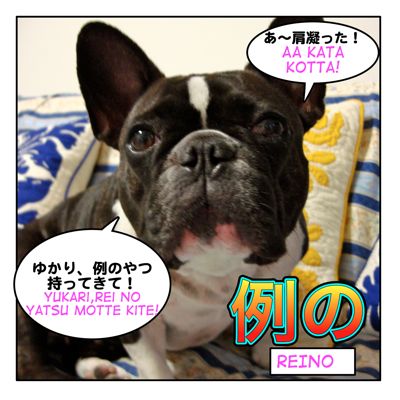「あ〜肩こった〜!」
= Aa. Kata kottaaa!
= Oh my shoulders are so tight…
「ゆかり、例のやつ持って来て!」
= Yukari, rei no yatsu motte kite!
= Yukari, bring me “that thing”!
Hi everyone! Are we ready to study today?
First let’s look at this kanji!
:u:
例 = tatoe / rei
It means “example“.
![]() 例えば = tatoeba = for example
例えば = tatoeba = for example
![]() 例 = rei = examples, Ex.
例 = rei = examples, Ex.
Now, today’s word is 例の = rei no + something / someone
We use it when we refer to a thing or a person without saying its or their name.
It’s like the English “thingamajig”, “watchamacallit”, “you-know-what”, “what-his/her/their-name”, “the”, “it”, or “that”.
You can also use this to avoid mentioning a name in public — in case you are trying to hide their identity.
Supposedly the listener should understand what the speaker is talking about by just hearing 例の= reino something / someone.
It makes things sounds more mysterious so we sometimes use it intentionally to create an aura of mystery to it.
Ex. 今、例の仕事で忙しいんだ。
= Ima rei no shigoto de isogashiinda.
= I have been busy with “that” work.
Ex. 例の件、どうなった?
= Rei no ken dounatta?
= What happened to “that” matter (in question)? (Or “So what happened to the “thing”?)
Ex. 例のことでちょっともめているんです。
= Rei no koto de chotto mometeirun desu.
= I’ve been having troubles since “you-know-what”.
Ex. 例の事件から彼女は外を出歩かなくなった。
= Rei no jiken kara kanojo wa soto wo dearukanaku natta.
= She hasn’t gone out since “that” incident.
Ex. ねえ、例のパーティー行く?
= Nee rei no paatii iku?
= Hey, are you going to “that” party?
Ex.例のあの機能がついています。
= Rei no ano kinou ga tsuite imasu.
= It has “that” function.
(Note: We can tell this machine does something illegal, and they don’t want to mention the name of the function.)
Ex. 例の彼が来るから準備して!
= Rei no kare ga kuru kara junbi shite!
= What’s-his-name is coming so be ready!
Ex. 今から例のところに行きます。
= Ima kara rei no tokoro ni ikimasu.
= I am going to you-know-where.
Occasionally we use it when we simply forget about a name.
Ex. 例のあれどうなった?
= Rei no are dounatta?
= What happened to “that” thing?
So what did Maggie sensei want?
:u:
「これ、これ!これが気持いいんだよね~!」
= Korekore! Kore ga kimochi iindaonee!
= This is just thing! It feel soooo good!
Can you tell what 例のやつ = rei no yatsu = thingamajig is in the picture? It is something like this.
:u:
It’s a type of neck massager. It works very well.
Japanese people tend to complain about their stiff shoulders = 肩凝り = katakori.
Hope this helps release my tension!
 マギー先生より = Maggie Sensei yori = From Maggie Sensei
マギー先生より = Maggie Sensei yori = From Maggie Sensei
例のサイトで例の言葉を教えている例の犬は私です。
= Rei no saito de rei no kotoba wo oshieteiru rei no inu wa watashi desu.
=I am that dog who teaches “that” language on “that” site!
***
Will you be my Patron?
I appreciate your support! サポートありがとう!




8 Comments
Hello Maggie-sensei. I have a question regarding the reading of パーティー
In the lesson, you wrote
ねえ、例のパーティー行く?
= Nee rei no paatei iku?
Is ティ read as ‘tea’ or テイ? I’ve always read it as ‘paatii’ all this time, so I am a little confused about this.
The romaji must be confusing.
Maybe I should have typed “paatii”. Will fix it later. :)
The pronunciation is “tea” in English.
Hello. Thanks for this great grammar point that can make us sound a bit more natural.
However I have a question regarding the connection. It seems that in some example the の directly attaches to the following noun, whereas some other times あの,あれ etc are place in between. Can you tell me more about the necessity to put it and the nuance that it introduces if optional.
例のあの機能がついています VS 今、例の仕事で忙しいんだ or 例の件、どうなった
Thanks in advance
PS: a romaji translation is not correct in this sentance
Ex.例の彼が来るから準備して!
= Rei no anohito ga kuru kara junbi shite!
@Juice
Hello, Juice.
First, thank you for spotting the mistake. I fixed it.
Now about your question, “例のあの機能がついています” is “It has “that” that function.” and it is redundant. I got the phrase from an actual advertisement line.
例の and あの they both are used when we can’t say what it is. It sounds mysterious yet very obvious.
But it gives more impact to draw listeners’ attention.
Okay, it’s clear now. Thanks again
very informative…
Hello Ms. Maggie Sensei!
I was able to listen to your twitaudio for listening practice.
it’s just that there were some sentences/words I’m not familiar with.
I was wondering if you could provide the transcript
to the link:http://twaud.io/xgR.
hoping for your reply.
@roulette225
OK, I will do that! BTW, if you are my follower on twitter, you can tweet me directly. That will be faster.